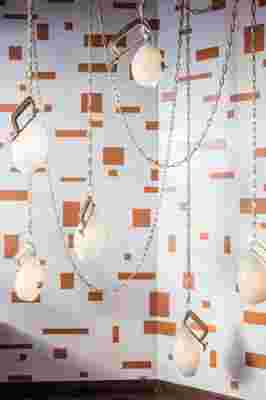Lindsey Adelman Debuts an Amazing New Line
Ten years after creating her iconic Branching Bubble light fixture—an illuminated network of metal tubes and handblown glass spheres—Brooklyn-based industrial designer Lindsey Adelman wants to get her hands dirty again. Case in point? The Ambrosia collection, which is about the furthest thing from those original light fixtures assembled from a simple list of components. This newest body of work—which went on display yesterday at New York shop the Future Perfect —comprises a series of one-of-a-kind pieces Adelman created with her own hands, in her own time.
“It felt freeing to work on this collection,” says Adelman. “To be able to follow my intuition and spontaneous tangents into a collection of disparate objects is satisfying and energizing. In a way, the work is so much more honest and vulnerable than my products.”
Crowning the entryway to the Lower East Side shop is a tangle of gold chains strung with white porcelain “petals” that hold oil-burning candles in slender glass test tubes. The fixture's flames must be lit by hand and will burn for around three hours. Beneath it, a selection of amorphous glass and ceramic vessels accented with gold chains, rope, and bits of leather channel a sort of romantic, shipwrecked quality, like a mix of barnacles and jewels washed up after years sunk at sea.

A strand of Adelman's Clamp lights is draped in front of a wallpaper designed by Callidus Guild.
In a new studio in Brooklyn’s Industry City (“It’s the place I go to be alone with my thoughts”), Adelman’s been experimenting with ceramics. “Being a beginner is humbling and also meditative,” she says. “Repetition and practice is a good method to learn a new skill. Being so hands-on, you learn about all the factors that affect a porcelain form—moistness, thickness, manipulation—and you learn to work with time as a partner.”
The decidedly ornamental quality to the new pieces is no accident—“I was looking at tribal dress, mainly of the Surma tribe in East Africa,” Adelman says. “I took a lot of time to come to terms with why I felt so moved by this type of design compared with what we usually call design in daily life here.”